Saltwater Chronicles (part 2)
| Sysadmin Note |
|---|
| Part 1 can be found here |
Pop-Ups
A Tale of Sink Tips, Mice & Minnows
Over the years I have written about a lot of different topics concerning the various methods of fly fishing and/or fly tying for a variety of different species. Seldom are the ideas on which I expound truly original or unique. Many of the ideas come from reading the older books of anglers of yesteryear, or perhaps the idea was planted after scanning an article in a magazine; or maybe it took root when I was exchanging information with another angler at the side of the river or across the deck of a boat. The point that I am trying to make is that there is very little in fly fishing that is new and undiscovered. Mostly what I try to do is share the knowledge that I have gathered over a fly fishing career that has covered a fifty year period. By doing so I hope to entertain and assist you by increasing your knowledge and giving you some interesting ideas to try out on the fish you chase with a fly rod.
Several years ago I began playing with the idea of flies - mostly mice and minnow imitations - that were tied to float on the surface of the water. Now, that in itself is not new - anglers and fly tiers have been tying and fishing these types of imitations for a long time. However, what I have been doing is mating the proper sized buoyant fly types with nine foot leaders and sink tip lines. This system, or method if you will, allows me to present the imitation deeper in the water column when stripping and it also allows the fly to pop to the surface when I stop the strip. Now, you might ask "Why is this important?"
Through observation in the field and by reading and talking to other anglers, it occurred to me that many of the predator fish attack their prey from below; coming from behind and up to the unsuspecting victim whenever they can. I have used this method on trout, bass, northern pike and also on several saltwater species and I can tell you that it is effective.
A couple of years ago I was fishing with my son in Florida. We were fishing on the Indian River very close to Sebastian Inlet. This happened in early June. The water was about ten feet deep, the day calm and the water was nice and clear. We had been catching Bluefish, Jacks and Ladyfish when six tarpon in the forty pound class swam into view. Well, I had a ten weight rod already rigged up with a sink tip (Type IV) and floating minnow imitation ready to go, as I had eagerly been waiting for a chance to try this method on the Silver Kings.
I quickly reeled in the eight weight rod I had been using and grabbed the ten weight; and by the Grace of God, I was able to place a cast out in front of those tarpon without spooking them into the next county. This, I might add, is what I normally do, you know - Spook them!
We could see the tarpon and we could see the fly. When I started to retrieve the imitation, the fly began to dive downward as it was pulled by the weight of the sink tip line, and we could see that the moment I paused in the stripping retrieve that fly started to swim towards the surface. If you have ever chased tarpon you will understand the excitement we felt when we saw one of the tarpon turn to chase the fly. Wow! One moment he was chasing the minnow and the next he was gone. I thought he had turned off as the fly was getting fairly close to the boat. I stopped the strip and the fly popped to the surface. I was already eyeing the other tarpon that seemed to be circling us and preparing to lift for another cast when that tarpon took the popped up streamer by rocketing out of the water. I only had eight or nine feet of fly line out beyond the tip of the rod.
My son and I both were extremely surprised; maybe shocked would be a better word. Almost without stopping the tarpon made four more leaps going away, (and even I was bowing to the fish with each jump) before the final leap when it fell back on the leader and that was the end of that!
Soon I was tying on a new streamer and my son, Ryan, was re-rigging his ten weight with a sink tip and a long leader. The tarpon were moving through that day and we had several more shots at them, with Ryan hooking and landing a nice forty pound tarpon on the pop-up rig and I hooked another, which jumped several times before throwing the fly. After this we experimented with these rigs using eight weight rods and took Blue Fish, Snook, Redfish, Ladyfish and Jacks all using the pop-up method. Now, lest you think that this is just a method for saltwater fish, let me tell you about a day on the Yellowstone River that happened just last summer.
Anyone who has spent much time on the Yellowstone River knows that it is one of the most challenging rivers in the west. The day before I had floated with two clients and done very well using hoppers, beetles and attractor dry flies. But, that was the day before, and even though the weather hadn't changed and there was no front moving in, there was some insect activity, the trout were not coming to the surface. We tried nymphing, both at mid-depth and bouncing the bottom. We even tried streamers on a full sinking line, but nothing. Well, to be honest we had taken a couple of smaller trout and several dandy whitefish, but the larger trout of the day before seemed to be taking the day off.
We were running out of things to try, when I suggested the "Pop-ups". We pulled over on a gravel bar, and switched rigs. I always carry a pair of eight weight rods in the boat when I am guiding. I explained the method and we walked across the gravel bar to the deep channel on the other side. I had rigged one angler up with a mouse and the other with a sculpin type minnow. Both patterns were tied to float and I had thoroughly dressed them with fly floatant. Well, they both took nice trout out of the channel, one rainbow and one brown. Not huge, but nice. With that we were off down the river, fishing out of the boat and stopping and fishing likely side channels and runs. When you are on the Yellowstone River, if you are just fishing out of the boat and not stopping, you will miss half of the excellent fishing opportunities the river has to offer.
By the end of the day we had taken rainbows, cutthroats and brown trout, all by using the Pop-up Method, including a nice twenty inch brown and a high flying eighteen inch rainbow. Oh, I should include the Merganser duck which spooked off the bank, ran through the leader and became hooked in the foot. That darn duck ran into the backing several times before we could get it under control and safely release it. By the way, be careful handling a hooked Merganser, as they are generally unhappy about the whole situation and will reward your attempt to release them with a bite or two! I guess it would not have taken so long if the guy rowing the boat and the other angler calling out encouragement had not been laughing so hard. But the situation was funny. Now, if by telling this I have offended some lover of birds (of which I am one.) The duck was not targeted nor hooked deliberately. We tried to point and pull and break off the duck, but 10 lb Maximum leader material is tough stuff.
I mention the leader in passing. When using this method you want a stiff material that will turn over these types of imitations. There is nothing worse than a limp leader and a fly in the back of the head to take the fun out of the moment.
Therefore, let me share with you the formula I use to build the leader when fishing the Pop-ups for trout or bass. I will also share my leader formula for saltwater, though I will tell you that I am going for effectiveness and care little for records. So, if you are interested in records you will have to use a different leader formula.
Trout & Bass Pop-up Leader Formula, 9 Foot Leader
This entire leader is constructed using Maximum Chameleon Leader Material. I use the Maximum for its stiffness, and therefore its ability to turn over large, buoyant flies when properly cast. First I create a loop with the fly line at the end of sink tip line. For the most part I am using eight, nine or ten weight Type IV Sink Tips. I attach the leader and fly line together using the loop to loop method. This works well for me though you may wish to do it another way. Every now and then I find that I didn't measure correctly and the leader is ten feet in length. Oh well, as long as it is performing I leave it alone.
I use the heavier sink tips because you need a certain amount of weight to draw the imitation downwards when you are stripping, but still allow the imitation to pop to the surface when you stop. I freely admit that I have not tried this with six and seven weight rods and lines; however, I feel that if the lines were mated with the proper sized and constructed imitation that it would work on these lighter lines as well.
Butt Section: 36" - 30 lb Looped with a Perfection Loop
Section Two: 18" - 25 lb
Section Three: 18" - 20 lb
Section Four: 12" - 15 lb Looped with a Double Surgeon's Loop
Tippet: 24" - 10 or 12 lb Looped with a Double Surgeon's Loop
Saltwater Pop-up Leader Formula, 9 Foot Leader
There are a great many saltwater leader materials which will work. I suggest using your favorite, as long as the butt section and section two of the leader are nice and stiff. My favorite saltwater leader material is Triple Fish.
As stated above, I use the loop-to-loop method for attaching my leader to my fly line and my tippets to my leader. I use the loop-to-loop method for my tippet to leader connection because it allows me to quickly change tippets as the situation demands.
Butt Section: 36"- 40 lb. Triple Fish with a Perfection Loop
Section Two: 36"- 30 lb. Triple Fish
Section Three: 18"- 25 lb. Triple Fish tied with a Double Surgeon's Loop
Bite Tippet: 18"- As Desired Triple Fish tied with a Double Surgeon's Loop
The strength of the Bite Tippet will depend on the species that you are working. Once again depending on the size of the tarpon, you will use anything from 40 lb. to 100 lb. When working other species 20 lb. to 30 lb. may be adequate. Trust me when I tell you that either of these leaders will turn over and deliver the large imitations.
I would like to share with you just a couple of the imitation types that I use for the Pop-Up method. After that, go forth, be innovative and create your own Pop-Up Imitations for the waters you fish.
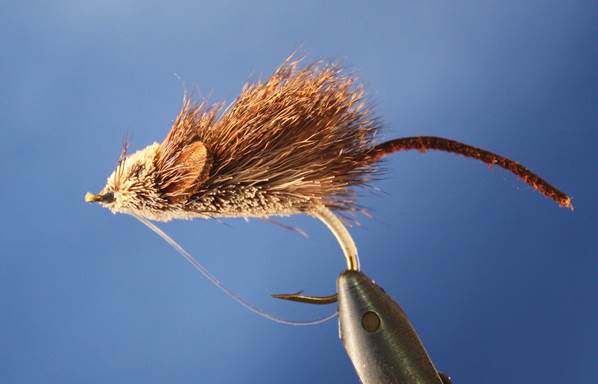
WHITLOCK'S NATURAL MOUSERAT
- Hook: TMC 8089 Size: 6
- Thread: 3/0 or A White in the back
3/0 or A Black in the front - Weed guard: 20 or 25 Mason Hard Nylon
- Tail: Tapered strip of Tan Chamois
- Body: Natural Deer Hair
- Ears: Tan Chamois
- Head: Natural Deer Hair
- Eyes: Black Pantone or Black 3-D
- Whiskers: Black Moose Body Hair
I also tie this pattern in all black and all white.
I use this pattern on western rivers, bass ponds and have even taken snook in the saltwater on this style using the pop-up methods.
Another pattern which I use for the Pop-Up Method is a floating minnow style with a sculpin type head. Both freshwater and saltwater have sculpin type minnows. In the saltwater they (sculpins) are called Gobies. I tie these in several different colors depending on the water I am fishing. The following pattern will be described in one of my favorite color variations that I use while fishing the Indian River and Sebastian Inlet area in Florida.
Pop-Up Streamers
White & Chartreuse
- Hook: Mustad 34007 or 3407
- Thread: A White or to match head Color
Sizes: 2/0 to 6 - Body & Tails: White Marabou pulled through a section of Chartreuse E-Z body material
- Collar: White Deer Hair, Flared
- Head: White Deer Hair, Flared, packed, stacked and trimmed to shape
- Eyes: 3-D Yellow with black centers, applied with epoxy
Note: The hooks and thread will remain the same for all the recipes listed.
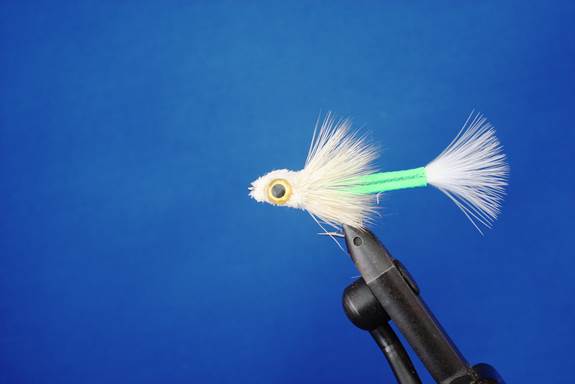
Purple & Black
- Body & Tails: Purple Marabou, pulled through Pearl E-Z body material
- Collar: Black Deer Hair, Flared, Purple Deer Hair, Flared
- Head: Black Deer Hair, Purple Deer Hair, flared, packed, stacked and trimmed to shape
- Eyes: 3-D, Red with Black centers, applied with epoxy
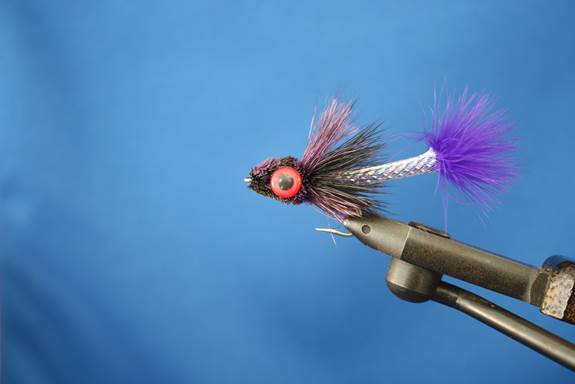
White & Pearl
- Body & Tail: White Marabou pulled through Pearl E-Z body material
- Collar: White Deer Hair, flared
- Head: White Deer Hair, flared, packed and stacked, trimmed to shape
- Eyes: 3-D, Yellow with Black centers, applied with epoxy
Note: This pattern is effective on Several Saltwater Species as well as Bass and Cutthroat Trout.
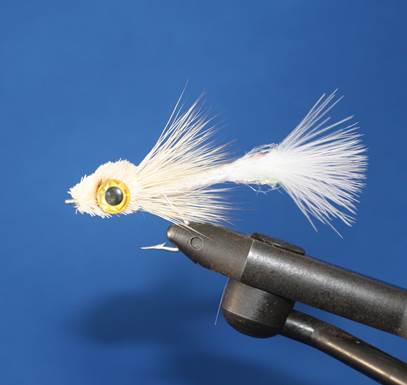
Chartreuse & Green
- Body & Tail: Chartreuse EP Fibers, pulled through Pearl E-Z Body Material.
The sides of the body are marked with a thin black line on either side using a Black Sharpie - Collar: Bottom, White Deer Hair, flared - Top, Green Deer Hair, flared
- Head: Bottom, White Deer Hair and Green Deer Hair on the top, all flared, stacked, packed and trimmed to shape
- Eyes: 3-D, Yellow with Black Centers, applied with epoxy
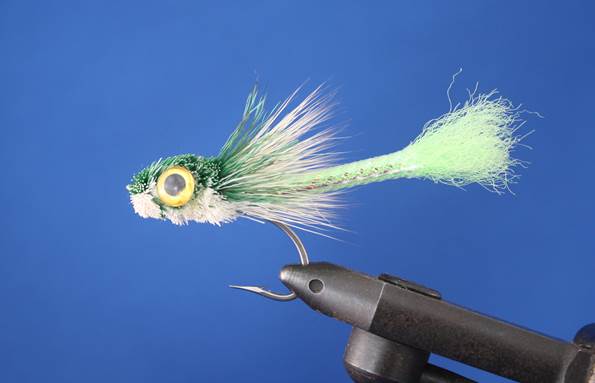
Mullet
- Body & Tail: EP Mullet Fibers pulled through Pearl E-Z body material
- Collar: Green Deer Hair, Flared
- Head: Gray Deer Hair, flared, packed, stacked and trimmed to shape
- Eyes: 3-D, Red with Black Centers, applied with epoxy
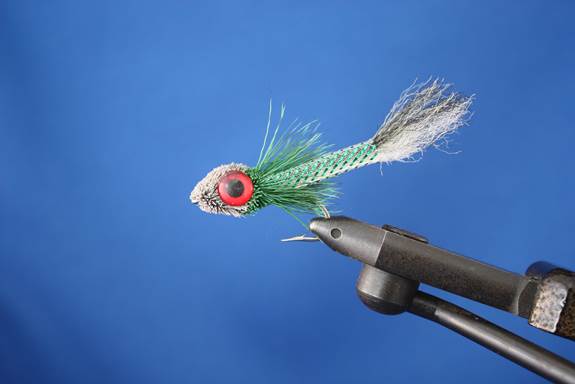
Yellow & White
- Body & Tail: Yellow Marabou drawn through Pearl E-Z body material
- Collar: 1st- White Deer Hair, flared, 2nd, Yellow Deer Hair, flared
- Head: Bottom—White Deer Hair, flared, packed and stacked
Top---Yellow Deer Hair, with Bands of White Deer Hair,
All packed, stacked and trimmed to shape. - Eyes: 3-D, Yellow with Black Centers, applied with epoxy
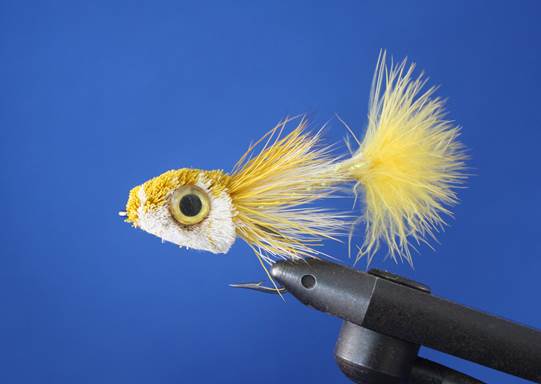
These patterns, when tied in proper sizes are effective on Saltwater Species, several Warm Water Species and on Trout. Tie some up, grab your high speed Hi D Sink Tip Line and give them a try. They have accounted for many memorable fish and lots of excitement for me and my friends.
Enjoy & Good Fishin'
| Sysadmin Note |
|---|
| Part 3 can be found here |
